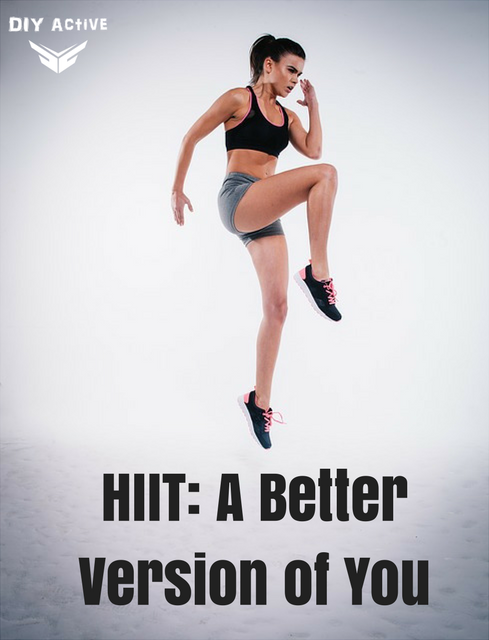This post may contain affiliate content from which we earn a small commission at no additional cost to you. Read our full disclosure.
High-Intensity Interval Training Will Make You Your Best Self Yet
Do you want to be the best you can be? That’s what athletes ask themselves all the time. But it’s a rhetorical question, meant only as a motivator. No matter what level of exerciser you are—a serious or recreational athlete, or simply an exercise enthusiast—if you take on high-intensity interval training (HIIT), this question is probably not a rhetorical one for you.
How Is HIIT Done?
High-intensity interval training is a technique that combines quick, intense bursts of exercise followed by easier rest bouts of recovery activity.
This type of training, which is basically a hard/easy system, is meant to increase endurance, strength, and metabolism.
High-intensity interval training is a very simple concept. After a quick warm-up, you are ready to introduce intervals. These consist of spurts of hard effort, typically between 20 to 90 seconds (but they can range anywhere from 10 seconds to two minutes, depending on the program).
The effort you put in should equal 80 percent of the maximum heart rate (MHR). You can keep track of your heart rate by wearing a monitor, and then calculate your percentages using a standard formula for MHR: 220 minus your age. Your recovery effort should be two to four times the length of your interval, done at about 40 percent of MHR.
You can also measure your interval efforts with a rate of 
If you’re a beginner, start with one HIIT session per week and work your way up to two. Three would be the number of sessions for someone advanced. Cap the length of the workout from start to finish at 30 minutes (less is fine). A classic measure for ensuring that you have not overdone a workout is the feeling at the end that you could do more if you had to.
Sports/exercises that lend themselves to HIIT include, but are not limited to:
- Cycling
- Gym routine (squats, jump rope, burpees, etc.)
- Rowing
- Running
- Swimming
- Walking
What Are the Benefits of HIIT?
In addition to being a more streamlined form of fitness, high-intensity interval training increases cardiovascular fitness, strength, and muscle mass and boosts the shedding of body fat. The HIIT workout can also improve bone density, balance, and coordination.
HIIT is time-efficient and alleviates boredom by offering variety and challenge.
Additionally, HIIT provides overall health benefits. According to a column in The New York Times, researchers have found that high-intensity exercise is maybe even more effective than one-dimensional aerobic activities for people with conditions such as diabetes, heart diseases, arthritis, and Parkinson’s disease, among others.
In order to ensure all of these benefits are realized, however, make sure you practice other good habits with your HIIT workout.
Is HIIT Safe?
High-intensity interval training is a strenuous workout and relies on the health and stability of the cardiovascular system, muscles, and joints. Those who are new to exercise or have a health condition that would put them at risk should only approach HIIT with the consent of a medical professional.
Like all exercises, HIIT has the potential for injury. However, it can be safe and effective if you follow certain basic rules:
- Always check with your doctor or other healthcare providers before undertaking HIIT or any exercise.
- Don’t push too hard, especially if you are sore, tired, or stressed in other aspects of your life.
- If you are new to exercise, build a base with mild-to-moderate activity before trying HIIT.
- Listen to your body. If something hurts or you feel ill, stop the workout.
- Rest sufficiently between bouts of HIIT.
- Warm up and cool down before and after HIIT (or any exercise).
If you are in general good health, but your hardcore activity results in injury, you’re not alone. It is an inherent risk for people who push their bodies. To that end, you should always practice good exercise safety habits. In addition, if you do incur an injury or experience prolonged pain, consult a sports medicine expert. Whether it is for an evaluation or for treatments like physical therapy, the physicians in this branch of medicine have special training and experience in working with athletes and active people.
Wrap-Up
Is HIIT right for you? If you’re looking to change it up and maximize your workouts, if you’re looking to be the best you can be, then, yes, most definitely HIIT is right for you.
- Physical Brain Health Exercises for a Bigger Brain - December 10, 2023
- Hot Yoga at Home: A Simple Guide - April 4, 2023
- Diet Detour: 15 Tips On How To Get Back On Track - June 9, 2017
Disclosure: In the spirit of full disclosure, DIYactive.com may be compensated in exchange for featured placement of certain reviews or links on this website. View our full disclosure.